Naming of esters - Study guides, Class notes & Summaries
Looking for the best study guides, study notes and summaries about Naming of esters? On this page you'll find 32 study documents about Naming of esters.
Page 3 out of 32 results
Sort by
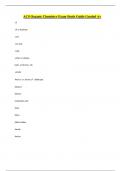
-
ACS Organic Chemistry Exam Study Guide Graded A+
- Exam (elaborations) • 9 pages • 2024
-
Available in package deal
-
- $10.03
- + learn more
ACS Organic Chemistry Exam Study Guide Graded A+ -al -ol or hydroxy- -one -oic acid -oate -ether or alkoxy- Iodo- or Bromo- etc. -amide Amino- or -amine ️Aldehyde Alcohol Ketone Carboxylic acid Ester Ether Alkyl halides Amide Amine Constitutional Isomer ️A compound with the same atoms but different atoms bonded to each other Stereoisomers ️Molecules with the same atoms differing only in 3D configuration Enantiomers ️Stereoisomers with exactly opposite stereoc...
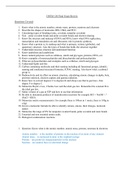
-
CHEM 120 Final Exam Review
- Exam (elaborations) • 7 pages • 2022
-
- $12.49
- + learn more
CHEM 120 Final Exam Review Questions Covered 1. Know what is the atomic number, atomic mass, protons, neutrons and electrons 2. Describe the shapes of molecules H2S, CBr4, and PCl3 3. Calculating types of bonding (ionic, covalent, nonpolar covalent) 4. Non – polar covalent bonds and polar covalent bonds and electron sharing 5. Know the structure and makeup of DNA and RNA, know what DNA replication, transcription and translation are and ribosomes role in protein synthesis. 6. Know wh...
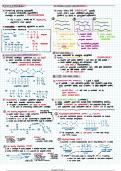
-
Year 12 Chemistry ATAR review notes - WA
- Summary • 14 pages • 2023
-
- $7.99
- + learn more
Digital notes that cover the year 12 ATAR chemistry textbook for WA. I wrote these notes to review for my school and WACE exams. This is my first time trying this out and am starting by just using the notes that I personally used to study with. Has detailed notes on topics explore in organic chemistry; polymers, polymerization, cross-links, polyethene, polyesters, polyamides, proteins, structures, side chains, functional groups, zwitterions, naming, fats, oils, soaps, enzymes, catalysts, gree...
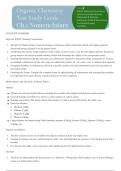
-
Organic chemistry test study guide for iupac naming conventions hydrocarbons alcohols aldehydes ketones carboxylic acids derivatives functional groups concept summary good for mcat pre
- Class notes • 3 pages • 2024
- Available in package deal
-
- $9.64
- + learn more
Organic Chemistry Test Study Guide: IUPAC Naming Conventions Hydrocarbons Alkanes: Saturated hydrocarbons with single bonds (C-C). Named using the suffix “-ane” (e.g., methane, ethane). Alkenes: Unsaturated hydrocarbons with at least one double bond (C=C). Named using the suffix “-ene” (e.g., ethene, propene). Alkynes: Unsaturated hydrocarbons with at least one triple bond (C≡C). Named using the suffix “-yne” (e.g., ethyne, propyne). Alcohols Contain a hydroxyl group (-...
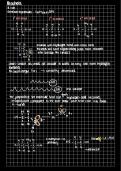
-
Summary - Unit 3.3.5 - Alcohols (Chem)
- Summary • 8 pages • 2024
-
- $9.62
- + learn more
Alcohols are a class of organic compounds characterized by the presence of one or more hydroxyl (-OH) groups attached to a carbon atom. Here are the key points about alcohols relevant to A-level chemistry: Structure and Classification General Formula: The general formula for alcohols is C n H 2 n + 1 O H C n H 2n+1 OH. Functional Group: The defining feature of alcohols is the hydroxyl (-OH) group. Classification: Alcohols are classified based on the number of...
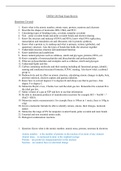
-
CHEM 120 Final Exam Review
- Exam (elaborations) • 7 pages • 2022
-
- $12.49
- + learn more
CHEM 120 Final Exam Review Questions Covered 1. Know what is the atomic number, atomic mass, protons, neutrons and electrons 2. Describe the shapes of molecules H2S, CBr4, and PCl3 3. Calculating types of bonding (ionic, covalent, nonpolar covalent) 4. Non – polar covalent bonds and polar covalent bonds and electron sharing 5. Know the structure and makeup of DNA and RNA, know what DNA replication, transcription and translation are and ribosomes role in protein synthesis. 6. Know wh...
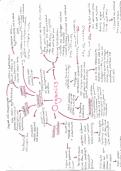
-
GCSE Higher Chemistry Organics I and II
- Summary • 3 pages • 2023
-
- $10.07
- + learn more
Mind-maps made by a grade 9 student, providing an overview of both Organics 1 and 2, including processes of forming esters, alcohols, carboxylic acids, alkanes and alkenes. As well as information on fractional distillation and cracking processes, the method of naming hydrocarbons, fuels and fermentation. Displayed formula of all the main homologous groups required at GCSE. Also details amino acids, DNA, properties of polymers and methods of polymerisation, displayed for ease of understanding usi...
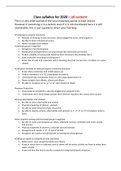
-
CHEM1007 Syllabus and all Content Topics Exam
- Summary • 4 pages • 2023
-
- $8.39
- + learn more
These notes provide a comprehensive overview of key concepts and principles in the chemistry generally taught in the second semester of first year of university. The notes cover all topics taught in CHEM 1007. Each topic is presented in a clear and concise manner, making it easy to understand and retain the information making it a good study tool when revising for end of semester examination. Syllabus and all content topics for Chemistry 101, CHEM1007 from every single lecture. Will assist i...
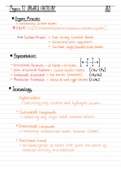
-
Matric Organic Chemistry Notes
- Summary • 7 pages • 2023
-
Available in package deal
-
- $8.88
- + learn more
High Quality digital summary notes of Gr 12 Organic Chemistry Section taken from class notes and the SAGS. Includes organic molecules, representation (structural, condensed, molecular formula), terminology (hydrocarbons, un/saturated, functional group), homologous series (alkanes, alkenes, haloalkanes, alcohols, carboxylic acids, esters), instructions for naming (IUPAC), and isomers. As well as detailed equations and examples for organic reactions (combustion, substitution, addition, elim...
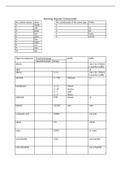
-
IUPAC nomenclature rules for A level
- Summary • 4 pages • 2022
-
- $4.02
- + learn more
A comprehensive guide to the IUPAC rules for naming organic compounds, including nomenclature rules for a range of molecules studied at both AS and A2 level. This was designed for the OCR A level specification, but can be used for any A level chemistry exam, including AQA and edexcel. The organic compound list includes: alkanes, alkenes, alcohols, polymers, haloalkanes/halogenoalkanes, aldehydes, ketones, carboxylic acids, esters, acid anhydrides, acyl chlorides, amines, amides, benzene, phen...

Study stress? For sellers on Stuvia, these are actually golden times. KA-CHING! Earn from your study resources too and start uploading now. Discover all about earning on Stuvia


